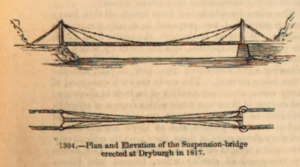Dryburgh Abbey Bridge facts for kids
The Dryburgh Abbey Bridge was a very old and important footbridge in Scotland. It was built near Dryburgh Abbey in the Scottish Borders. This bridge connected the villages of Dryburgh and St Boswells across the River Tweed. For hundreds of years, people had crossed the river here, first by a ferry boat.
Contents
Dryburgh Abbey Bridge: A Story of Innovation and Collapse
Building the First Bridge (1817-1818)
The idea for the bridge came from David Stewart Erskine, 11th Earl of Buchan. He was a Scottish nobleman who was known for being a bit unusual or "eccentric." He wanted a new way for people to cross the river.
The bridge was about 79 meters (259 feet) long. It was a special type of bridge called a cable-stayed bridge. This means it used strong cables connected from tall towers to the bridge deck to hold it up. At that time, this type of bridge was becoming very popular.
The Earl opened the first Dryburgh Abbey Bridge on August 1, 1817. But sadly, just a few months later, in January 1818, the bridge fell down. One of the people who helped design it said that a "perfect hurricane" of wind destroyed it in just one hour.
Why Did It Collapse?
The collapse of the Dryburgh Abbey Bridge in 1818 was a big deal. Another similar bridge in Germany also fell down a few years later, in 1824. These events made people lose trust in cable-stayed bridges.
Even though this type of bridge had been around since the 1600s, people stopped building them for over 100 years. Instead, they preferred suspension bridges, which looked a bit different and seemed safer.
The Second Bridge and Its Fate (1818-1838)
After the first bridge collapsed, a new one was built to replace it. This second bridge was also a cable-stayed design. However, it also fell down in 1838. By this time, the Earl who had first wanted the bridge had already passed away.
The Comeback of Cable-Stayed Bridges
Even though the Dryburgh Abbey Bridge failed twice, the story of cable-stayed bridges didn't end there. In the 1930s, engineers started to study them again. After World War II, when many bridges needed to be rebuilt, they realized that cable-stayed bridges could actually be very strong and useful if designed correctly.
The first modern cable-stayed bridge was the Strömsund Bridge in Sweden, finished in 1955. Today, you can see many amazing cable-stayed bridges all over the world.
Other Bridges in the Area
Very soon after the first Dryburgh Abbey Bridge collapsed, another famous bridge was built nearby. This was the Union Bridge, built between 1819 and 1820. It was about 40 kilometers (25 miles) downstream from Dryburgh. The Union Bridge was an iron suspension bridge, and when it was finished, it was the longest in the world!
Later, in 1872, a third bridge called the Dryburgh Suspension Bridge was built at the Dryburgh Abbey site. This one was a suspension bridge, replacing the second cable-stayed bridge that had fallen in 1838.



